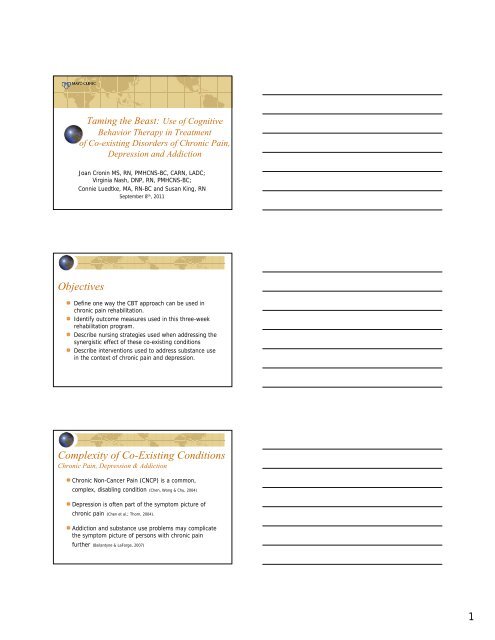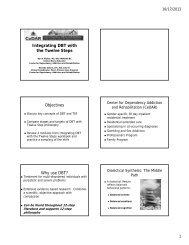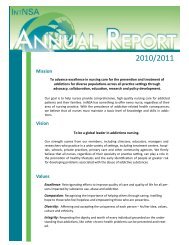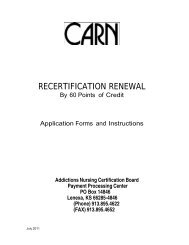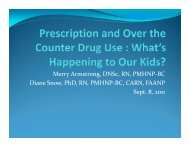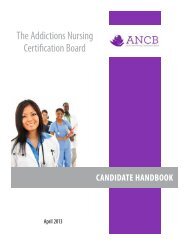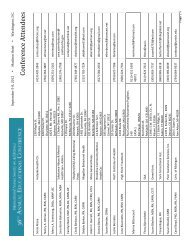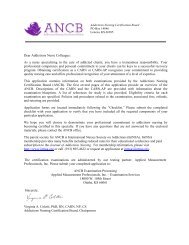C1-D1. Taming the Beast: Use of Cognitive Behavioral Therapy (CBT)
C1-D1. Taming the Beast: Use of Cognitive Behavioral Therapy (CBT)
C1-D1. Taming the Beast: Use of Cognitive Behavioral Therapy (CBT)
Create successful ePaper yourself
Turn your PDF publications into a flip-book with our unique Google optimized e-Paper software.
<strong>Taming</strong> <strong>the</strong> <strong>Beast</strong>: <strong>Use</strong> <strong>of</strong> <strong>Cognitive</strong>Behavior <strong>Therapy</strong> in Treatment<strong>of</strong> Co-existing Disorders <strong>of</strong> Chronic Pain,Depression and AddictionJoan Cronin MS, RN, PMHCNS-BC, CARN, LADC;Virginia Nash, DNP, RN, PMHCNS-BC;Connie Luedtke, MA, RN-BC and Susan King, RNSeptember 8 th , 2011ObjectivesDefine one way <strong>the</strong> <strong>CBT</strong> approach can be used inchronic pain rehabilitation.Identify outcome measures used in this three-weekrehabilitation program.Describe nursing strategies used when addressing <strong>the</strong>synergistic effect <strong>of</strong> <strong>the</strong>se co-existing conditionsDescribe interventions used to address substance usein <strong>the</strong> context <strong>of</strong> chronic pain and depression.Complexity <strong>of</strong> Co-Existing ConditionsChronic Pain, Depression & AddictionChronic Non-Cancer Pain (CNCP) is a common,complex, disabling condition (Chen, Wong & Chu, 2004)Depression is <strong>of</strong>ten part <strong>of</strong> <strong>the</strong> symptom picture <strong>of</strong>chronic pain (Chen et al.; Thorn, 2004).Addiction and substance use problems may complicate<strong>the</strong> symptom picture <strong>of</strong> persons with chronic painfur<strong>the</strong>r (Ballantyne & LaForge, 2007)1
Complexity <strong>of</strong> Co-Existing ConditionsChronic Pain & Addiction“Patients who experience ei<strong>the</strong>r addiction or painhave historically shared being misunderstood,underdiagnosed, and undertreated. Whenindividuals experience coexisting chemicaldependency and pain, this experience isamplified.” (Trafton, Oliva, Horst, Minkel, & Humphreys, 2004as quoted from St. Marie, 2010 page 623)Assessment Tools forChronic Pain & Addiction“Addictions and pain literature have inspired tooldevelopment to identify patients who are atrisk for abusing prescription pain medicationsused to treat <strong>the</strong>ir pain…specialists havecriticized DSM-IV as inappropriate foridentifying opioid misuse in pain patients”(Savage, 1999; Sees & Clark, 1993 as quoted in St. Marie, 2010,p. 621)What is Chronic Pain?An unpleasant sensory and emotionalexperience associated with actual or potentialtissue damage, or described in terms <strong>of</strong> suchdamage....Pain is always subjective....It isunquestionably a sensation in apart or parts <strong>of</strong><strong>the</strong> body, but it is also always unpleasant and<strong>the</strong>refore also an emotional experience.(IASP, 1994)2
What is Chronic Pain?The IASP and many pain experts deemthat in many cases, chronic pain is adisease in its own right (EFIC, 2001), aposition supported by <strong>the</strong> Institute <strong>of</strong>Medicine Report June 29, 2011Chronic PainPain is a universal experience. Commonchronic pain conditions affect at least116 million U.S. adultsCosting $560–635 billion annually indirect medical treatment costs and lostproductivityRelieving Pain in America: A Blueprint for Transforming Prevention, Care, Education,and Research. Institute <strong>of</strong> Medicine Report June 29, 2011DepressionDepression rates among persons with chronicpain is 3-4 times higher than <strong>the</strong> generalpopulation. (Sullivan, Reesor, & Fisher, 1992)Overlapping symptoms <strong>of</strong> pain and depression<strong>CBT</strong>-evidence based treatment formanagement <strong>of</strong> depression3
What is AddictionPrimary, chronic, neurobiologic disease, with genetic,psychosocial, and environmental factors influencingits development and manifestations. It ischaracterized by behaviors that include one or more<strong>of</strong> <strong>the</strong> following: impaired control over drug use,compulsive use, continued use despite harm andcraving.American Academy <strong>of</strong> Pain Medicine, American Pain Society, American Society <strong>of</strong> PainManagement Nurses, and American Society <strong>of</strong> Addiction MedicinePhysical DependencePhysical dependence is a state <strong>of</strong> adaptationmanifested by withdrawal syndrome,produced by abrupt cessation, rapid dosereduction, or decreasing blood levels <strong>of</strong> <strong>the</strong>drug.American Academy <strong>of</strong> Pain Medicine, American Pain Society, American Society <strong>of</strong> PainManagement Nurses, and American Society <strong>of</strong> Addiction Medicine“The Elephant in <strong>the</strong> Living Room”Addiction4
“The Elephant in <strong>the</strong> Living Room”Chronic pain“The Elephant in <strong>the</strong> Living Room”Depression‘The Elephant in <strong>the</strong> Living Room”Chronic pain+ Depression+ Addiction“The <strong>Beast</strong>”5
Establishing <strong>the</strong> Efficacy <strong>of</strong> <strong>CBT</strong> forTreatment <strong>of</strong> Chronic PainInternational Association for <strong>the</strong> Study Pain in <strong>the</strong>10 th World Congress (2005)<strong>Cognitive</strong> <strong>Behavioral</strong> <strong>Therapy</strong> is as effective for aheterogeneous group <strong>of</strong> chronic pain sufferers as anypublished <strong>the</strong>rapy for any specific type <strong>of</strong> painEfficacy <strong>of</strong> <strong>CBT</strong> for Chronic PainTurk (2002) Review <strong>of</strong> comprehensive pain rehabilitation programsMore cost effective than implantation <strong>of</strong> spinal cordstimulators, intraspinal drug delivery systems/surgery.Significantly greater reduction in medication use, and healthcare utilizationSignificantly greater increases in functional activities, returnto work, closure <strong>of</strong> disability claimsSubstantially fewer iatrogenic consequences/adverse events.Multidisciplinary Pain Rehabilitation<strong>Cognitive</strong>-behavioral approachImprovement <strong>of</strong> physical functioningImproved general functional status (ADLs, social,household, recreational)Improved vocational/school functioningReduction in health care utilizationReduction/discontinuation <strong>of</strong> opioids, sedativehypnoticand over <strong>the</strong> counter medicationsReduction in pain level (not always attainable)6
APS Task Force Review (2006) - Compared to differenttreatment modalities including <strong>the</strong> standard medical approachor medication management, MPRP is <strong>the</strong> only <strong>the</strong>rapeuticapproach that has demonstrated treatment efficacy and costeffectivenessfor functional restoration and major outcomevariables (pain severity, healthcare utilization, medication use,disability claims).Overview <strong>of</strong> Mayo Clinic ComprehensivePain Rehabilitation Center (PRC)Three week program developed in 1974 in Rochester, MN~450 patients annuallyPatients average length with chronic pain~ 9+ yearsBack pain, fibromyalgia & headache most commonParticipants range in age from 13 to 90Focus on functional restoration and quality <strong>of</strong> lifeDiscontinuation <strong>of</strong> opioids for pain while learning o<strong>the</strong>rcognitive-behavioral strategies for coping7
Overview <strong>of</strong> Pain Rehabilitation Center3 week program with rolling admission20-30 patients at any given time, divided in 2 teamsMonday – Friday 8 a.m. to 5 p.m.2 day family education programAftercare programPREP - 2 day pain rehabilitation executive program3 week Adolescent program with extensive parent programmingComprehensive Multidisciplinary TeamPatientPhysiciansPsychologistsClinical nurse specialistsRN case managersPhysical <strong>the</strong>rapyOccupational <strong>the</strong>rapyPharmacistDietitianChaplainsVocational counselorTobacco treatmentspecialistsClinical assistantsSecretaryPain Control Methods Commonly <strong>Use</strong>dPrior to PRCMedicationsSurgeriesInjectionsStimulatorsImplanted pumpsComplementary &alternative medicineVarious proceduresPhysical <strong>the</strong>rapyRestYou name it!8
Just Say No to Drugs???Can this REALLY be an alternative treatmentto opioid <strong>the</strong>rapy??Opioid <strong>Therapy</strong> for Chronic PainEarly 1990s national pain organizations challenged <strong>the</strong>nation to provide better pain management to all patientsIt was determined that <strong>the</strong>re need not be an “upper limit”for opioid prescriptions for those in painIn 1997, APS and AAPM issued consensus statement thatopioid <strong>the</strong>rapy for Chronic Non-Cancer Pain is a legitimatemedical practiceMinimized concerns <strong>of</strong> addiction, respiratorydepression and o<strong>the</strong>r side effects, and tolerance1997 to 2006 - 90% increase in opioid prescriptionsBut, is it Effective?Six meta-analyses and reviews <strong>of</strong> randomized, double-blind,placebo-controlled trials <strong>of</strong> opioids for CNCPFlawed Empirical EfficacySignificant drop out rates/exclusion criteriaVery short-term outcomes (avg. 5 weeks!)Lack <strong>of</strong> clinically significant reduction in painNo documented improvement in functioningPossible publication bias9
But, is it Effective?Additional Reasons for ConcernTolerance/Dependence, AddictionPossible Opioid-induced HyperalgesiaOpioids maintained despite decline infunctioning and no improvement in pain (fearmotivated?)Pain behaviors predict physicians’prescriptionsWhat did <strong>the</strong> Consensus statement REALLY say??“periodic reexamination is warranted toassess <strong>the</strong> nature <strong>of</strong> <strong>the</strong> pain complaint andto ensure that opioid <strong>the</strong>rapy is still indicated.Attention should be given to <strong>the</strong> possibility <strong>of</strong>a decrease in global function or quality <strong>of</strong> lifeas a result <strong>of</strong> opioid use” [1997, p. 3].What did <strong>the</strong> Consensus statement REALLY say??“Consideration should be given to differenttreatment modalities, such as a formal painrehabilitation program, <strong>the</strong> use <strong>of</strong> behavioralstrategies, <strong>the</strong> use <strong>of</strong> noninvasive techniques,or <strong>the</strong> use <strong>of</strong> medications, depending upon<strong>the</strong> physical and psychosocial impairmentrelated to <strong>the</strong> pain” [1997, p. 3].10
What has Really Happened?Interactive map show state by state annual change inprescription narcotic consumption (1997-2006)AZ had a 640% increase in oxycodone consumption (#6 incountry DE was #1)Money spent on Marketing for opioids increased from $11to $30 billionSpending on outpatient prescriptions tripled in 10 years(4.2 in 1996 to 13.2 billion in 2006; AHRQ, 2009)1999-2006, fatal poisonings involving opioids more thantripled from 4,000 to 13,8000 (NCHS, 2009)http://www.lasvegassun.com/multimedia/rx_interactive/Evidence-based practice guidelines forCNCP and opioidsConclusionICSI, 2008; Sanders et al., 2005Controlled opioid trials have limited applicability to<strong>the</strong> long-term use <strong>of</strong> opioids in clinical practiceClinicians should consider o<strong>the</strong>r forms <strong>of</strong>treatment including rehabilitation approach thatemphasizes self-management and functionalrestorationPain 140 (2008) 177-18911
<strong>CBT</strong> Goals <strong>of</strong> <strong>the</strong> Mayo PRCLearn healthy ways <strong>of</strong> responding to flares <strong>of</strong> chronicpainPractice lifestyle self-management approachNot from one prescription or procedure to <strong>the</strong> nextFocus on functional goalsSkills trainingIncrease <strong>the</strong> controllability <strong>of</strong> own pain and quality <strong>of</strong>lifeDeveloping ResiliencyReplace pain contingent lifestyle<strong>CBT</strong> Triangle<strong>CBT</strong> Focused GroupsIdentifying relationships between thoughts, moods, andbehaviorsIdentifying, challenging & changing maladaptive thoughtpatternsThoughtsMoodsBehaviors<strong>Cognitive</strong>-<strong>Behavioral</strong> TechniquesNo single coping technique has proven to beuniversally effective –It is <strong>the</strong> combination <strong>of</strong> multiple personalizedtechniques incorporated into one’s lifestyle thatleads to success in restoring functioning and quality<strong>of</strong> life<strong>CBT</strong> can be used at any time during course <strong>of</strong> pain– not solely after failure <strong>of</strong> o<strong>the</strong>r treatments12
<strong>Cognitive</strong>-<strong>Behavioral</strong> TechniquesPatient education –• Acute vs. Chronic pain• Central SensitizationReinforce wellness behaviors• responses to pain, generates consequences– Behavior rewarded is behavior repeated– Behavior not rewarded is “extinguished”• avoidance• verbal/nonverbal pain behaviors<strong>Cognitive</strong>-<strong>Behavioral</strong> TechniquesRegular exercise – reverse deconditioning• hurt ≠ harm;• gradual and progressiveAppropriate Pacing <strong>of</strong> activities• “push-crash-burn” cycle• Appropriate ergonomics (PT/OT)Sleep hygiene, sleep restriction• sleep efficiency• Treat as primary insomnia using <strong>CBT</strong><strong>Cognitive</strong>-<strong>Behavioral</strong> TechniquesDistraction• humor, leisure and pleasant activities, hobbiesStress managementRelaxation Training• bi<strong>of</strong>eedback, diaphragmatic breathing imagery,progressive muscle relaxation, yoga13
<strong>Cognitive</strong>-<strong>Behavioral</strong> TechniquesGrief and Loss –New Identity beyond pain and being a patientCommunication/Assertiveness trainingFamily education and trainingRelapse prevention/problem solving• “difficult day plan for managing flares”<strong>Cognitive</strong>-<strong>Behavioral</strong> Techniques<strong>Cognitive</strong> restructuring• pain catastrophizing;• controllability,• positive coping• Challenge rigid thinkingThought Record: One Technique(ABCDE format by Aaron Beck)Activating EventTriggers, context (i.e. losing a job and having chronic pain)BeliefNegative, inaccurate, automatic thoughts (i.e. “I’m a loser!”)ConsequencesFeelings (i.e. angry, sad)Behaviors (i.e. isolate, don’t take care <strong>of</strong> self)14
Thought Record(ABCDE format by Aaron Beck)DebateEvidence supporting belief• (i.e. lost job; feel like a loser)Evidence not supporting belief• (i.e. look at o<strong>the</strong>r successes; chronic pain is not synonymous withbeing a “loser”; focus on what is possible)Exciting New Conclusions(i.e." Losing a job and having chronic pain does not mean Iam a loser! I can focus on taking care <strong>of</strong> myself and what ispossible.”)Managing Co-Existing ConditionsChronic pain, depression & addiction<strong>Cognitive</strong> behavioral strategies have been shown to improvedepression and help persons effectively manage chronic pain(Bennett & Nelson, 2006; Chen et al, 2004; Turk, 2003; Wells-Federman, Arnstein, Caudill,2002; Wells-Federman, Arnstein, Caudill-Slosberg 2003)<strong>Cognitive</strong> behavioral strategies including pain managementcombined with relapse prevention has been shown to helppersons with substance use disorders and chronic pain todecrease pain, manage emotions, and reduce medicationreliance (Currie, S., Hodgins, D., Crabtree, A., Jacobi, J. & Armstrong, S., 2003)Bewildered by <strong>the</strong> <strong>Beast</strong>Programs not equipped to deal with <strong>the</strong>se coexistingdisordersIncreased number <strong>of</strong> patients on opioidsIncreased polypharmacyHigher daily morphine equivalentsDissatisfaction <strong>of</strong> medication use by patients,providers, and familiesMultitude <strong>of</strong> risks associated with use <strong>of</strong> opioids15
Percentage <strong>of</strong> Patients UsingOpioids at Admission70Percent6050402002 2003 2004 2005 2006 2007 2008 2009 2010YearMean Daily Morphine EquivalenceDosage (MED) on AdmissionMED (mg)14013012011010090802002 2003 2004 2005 2006 2007 2008 2009 2010YearPercentage <strong>of</strong> Patients UsingBenzodiazepines at Admission5040Percent30201002002 2003 2004 2005 2006 2007 2008 2009 2010Year16
Percentage <strong>of</strong> Patients Using Trifectaat AdmissionPercent16141210864202002 2003 2004 2005 2006 2007 2008 2009 2010YearPercentage <strong>of</strong> Patients UsingStimulants at AdmissionPercent1210864202002 2003 2004 2005 2006 2007 2008 2009 2010YearAcknowledging <strong>the</strong> <strong>Beast</strong> in <strong>the</strong> RoomTalking about our preconceptions and biasesImprove knowledge and skill <strong>of</strong> taperingopioids- Clinical Opiate Withdrawal ScaleOngoing discussions with staff,patients/familiesCreating and using neutral languageAllowing <strong>the</strong> process <strong>of</strong> change to occur17
<strong>Taming</strong> <strong>the</strong> <strong>Beast</strong>Building rapport – developing trustNonjudgmental approachHybridized-skilled assessmentValidating patient’s personal experiencePatient AdvocateEstablishment <strong>of</strong> safe medication tapersKnowledge and understanding <strong>of</strong> substanceuse disorders & painC.O.R.E. versus M.O.S.T.Continued Opportunity for RehabilitativeExperienceMore Opportunity for Successful TomorrowsWhich option?Criteria for recommendationM.O.S.TStronger focus on risks <strong>of</strong> mood alteringsubstances misuse/abuse based on:Past /present use <strong>of</strong> mood altering substances<strong>Use</strong> <strong>of</strong> pain medications in ways o<strong>the</strong>r thanprescribed, (i.e. anxiety, stress)Concerns expressed by family or healthcare providersAberrant behaviorsGenetic predispositionHealth risks18
M.O.S.T.Goal: Increase awareness <strong>of</strong> substanceuse risks and provide ongoing education,recommendations and resources asneeded.Preparing <strong>the</strong> Patient for MOSTMotivational interviewing and Stages <strong>of</strong> ChangeGa<strong>the</strong>ring informationPatient-history <strong>of</strong> substance use, current use,misuse/abuse <strong>of</strong> substances including medications,alcohol, illicit drugs, and patient concernsFamily and home provider inputPRC treatment team makes recommendationbased on information ga<strong>the</strong>redPatient can ultimately make <strong>the</strong> choiceWhat happens in MOSTTherapist style-nonjudgmentalConfidential-trust within group (no labels,judgment, criticism, blame)Focus on how substance use affects life (notpain stories)Provide an environment for self reflectionEducation regarding substance use19
Group Topics in MOSTPhysical/medical aspects <strong>of</strong> substance abuseincluding disease modelCycle <strong>of</strong> pain and substance usePersonal use patterns-sharing time lineFamily aspects, history, effects onrelationship, family concernsManaging high risk situations, triggers foruse, avoiding cross-addiction and o<strong>the</strong>r risksPossible Next Steps for MOST PatientsWhen <strong>the</strong> patient is readyUsing SAMSHA, provide information about treatment programsProvide support and encouragement during transitionWhen <strong>the</strong> patient is not readyProvide a clear message to patient, his/her support persons, andhome providers about PRC recommendation for treatmentUsing SAMSHA, provide information about treatment programsKeeping <strong>the</strong> doors openOutcome MeasuresMultidimensional Pain Inventory (MPI)• Pain Severity and Suffering• Life InterferencePain Catastrophizing ScalePain Self-Efficacy ScaleCES-D• Depression20
DemographicsCORE (n=230) MOST (n=246)Age 47 47Education (years) 14.8 14.6Duration <strong>of</strong> pain(years)Years takingnarcotic12.1 11.35.2 5.2% Married 48% 51%Admit BMI 29.5 29.5Type <strong>the</strong> footnote/source in this space61OPIOIDS, BENZOS, AND SEDATIVES/HYPNOTICS…A LETHAL TRIFECTAN=476 CORE MOSTOpioid 36% 64%Benzodiazepine 38% 62%Sedative/hypnotic 43% 57%LETHAL TRIFECTA 7% 18%p < 0.001p < 0.001P=0.08p
O<strong>the</strong>r DrugsCORE MOSTTobacco use 20% 80%Past CD Tx 17% 83%% Current 50% 50%alcohol use% Past heavy 6% 27%Alcohol <strong>Use</strong>& Daily alcohol 8% 19%useMarijuana use 0.4% 13%P < 0.001P < 0.001nsP < 0.001Pain Severity (MPI)Mean T-Score(SD=10)6040200nsPREnsPOSTMOSTCOREWithin Subjectsp < .001(both groups)General Activity (MPI)Mean T-Score(SD=10)6050403020100nsPREnsPOSTMOSTCOREWithin Subjectsp < .001(both groups)22
Mean T-Score(SD=10)50403020100Pain Self-Efficacyp
Revelations: The <strong>Beast</strong> Can be Tamed!The way we approach patients mattersLanguage mattersTiming mattersThe relationship mattersRevelations: The <strong>Beast</strong> Can be Tamed!Awareness <strong>of</strong> <strong>the</strong>ir cycle <strong>of</strong> pain,substance use or depression is important,more so focusing on ways <strong>the</strong>se can bebrokenGaining knowledge specific to addiction,depression, chronic pain is beneficialAcceptance and application <strong>of</strong> conceptslead to positive outcomesReferencesASPMN Position Statement Pain Management in Patients with AddictiveDisease http://www.aspmn.org/Organization/documents/addictions_9pt.pdfBallantyne, J. & LaForge, S. (2007). Opioid dependence and addictionduring opioid treatment <strong>of</strong> chronic pain. Pain, 129, 235-255.Bennett, R., & Nelson, D. (2006). <strong>Cognitive</strong> behavioral <strong>the</strong>rapy forfibromyalgia. Nature Clinical Practice Rheumatology, 2 (8), 416-424.Chen, P.P., Wong, T.C., & Chu, M.C. (2004). Chronic pain management:A paradigm change. The Hong Kong Practitioner, 26,(6) 277-284.Retrieved on November 7, 2008 from British Libraryhttp://www.hkcfp.org.hk/article/2004/06/page277_283dp.html24
ReferencesCommittee on Advancing Pain Research, Care, and Education; & Board onHealth Sciences Policy. (June 29, 2011). Relieving pain in America: Ablueprint for transforming prevention, care, education, and research.Institute <strong>of</strong> Medicine <strong>of</strong> <strong>the</strong> National Academies; The NationalAcademies Press, Washington, D.C.Currie, S., Hodgins, D., Crabtee, A., Jacobi, J. & Armstrong, S. (2003).Outcome from integrated pain management treatment for recoveringsubstance abusers. The Journal <strong>of</strong> Pain, 4, (2), 91-100.Gatchell, R. J. & Okifuji, A. (2006). Evidence-based scientific datadocumenting <strong>the</strong> treatment and cost-effectiveness <strong>of</strong> comprehensivepain programs for chronic nonmalignant pain. The Journal <strong>of</strong> Pain, 7,11), 779-793.ReferencesInternational Association for <strong>the</strong> Prevention <strong>of</strong> Pain: Working toge<strong>the</strong>r forpain relief. http://www.iasppain.org/Content/NavigationMenu/WorldCongressonPain2/History/default.htmInstitute for Clinical Systems Improvement (2008, 3 rd edition). Health CareGuideline: Assessment and management <strong>of</strong> chronic pain.Sanders, S. H., Harden, R. N. and Vicente, P. J. (2005), Evidence-BasedClinical Practice Guidelines for Interdisciplinary Rehabilitation <strong>of</strong> ChronicNonmalignant Pain Syndrome Patients. Pain Practice, 5: 303–315.Savage, S. R. (1999). Opioid <strong>the</strong>rapy <strong>of</strong> chronic pain: Assessment <strong>of</strong>consequences. Acta Anase<strong>the</strong>siologica <strong>of</strong> Scandinavica, 43, 909-917.ReferencesSees, K. L., & Clark, H.W. (1993). Opioid use in <strong>the</strong> treatment <strong>of</strong> chronicpain: Assessment <strong>of</strong> addiction. Journal <strong>of</strong> <strong>the</strong> Pain and SymptomsManagement, 8, 257-264.Soligo, T. & Richards, A. (June 6, 2008). Prescription Narcotic Consumption;Perscription Narcotic Interactive Website. Las Vegas Sun.http://www.lasvegassun.com/multimedia/rx_interactive/Sullivan, M., Reesor, K., Mikail, S. & Fisher, R. (1992). The treatment <strong>of</strong>depression in chronic low back pain: Review and recommendations. Pain50, 5-13.25
ReferencesSt. Marie, B.J. (2010). Coexisting Addiction and Pain. In B.J. St. Marie(Ed.) Core Curriculum for Pain Management Nursing, 2 nd Edition.Dubuque, IA: Kendall-Hunt Publishers, pp. 617-629.Thorn, B. E. (2004). <strong>Cognitive</strong> <strong>the</strong>rapy for chronic pain. New York: TheGuilford Press.Townsend, C.O., Kerkvliet, J.L., Bruce, B.K., Rome, J.Dl, Hooten, W.Ml,Luedtke, C.A., & Hodgson, J.E. (2008). A longitudinal study <strong>of</strong> <strong>the</strong>efficacy <strong>of</strong> a comprehensive pain rehabilitation program with opioidwithdrawal: Comparison <strong>of</strong> treatment outcomes based on opioid usestatus at admission. Pain, 140, 177-189.ReferencesTrafton, J., Oliva, E.M., Horst, D.A., Minkel, J.D., & Humphreys, K.(2004). Treatment needs associated with pain in substance usedisorder patients: Implications for concurrent treatment. Drug andAlcohol Dependence, 73, 23-31.Turk, D,C. (2002). Clinical effectiveness and cost-effectiveness <strong>of</strong>treatments for patients with chronic pain. Clin J Pain, 18(6), 355-365.Turk, D. C., (2003). <strong>Cognitive</strong>-behavioral approach to <strong>the</strong> treatment <strong>of</strong>chronic pain patients. Regional Anes<strong>the</strong>sia and Pain Medicine, 28(6),573-579.ReferencesWells-Federman, C., Arnstein, P., & Caudill, M. (2002). Nurse-ledmanagement program: Effect on self-efficacy, pain intensity, painrelateddisability, and depressive symptoms in chronic pain patients.Pain Management Nursing, 3 (4), 131-140.Wells-Federman, C., Arnstein, P., & Caudill-Slosberg, M. (2003).Comparing patients with fibromyalgia and chronic low back painparticipating in an outpatient cognitive-behavioral treatmentprogram. Journal <strong>of</strong> Musculoskeletal Pain, 11(3), 5-12.26


